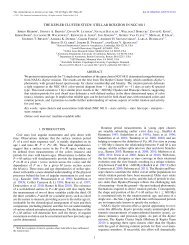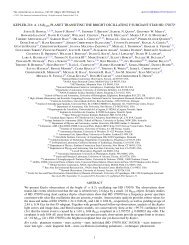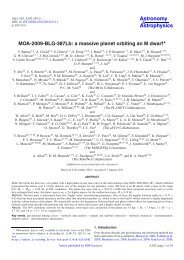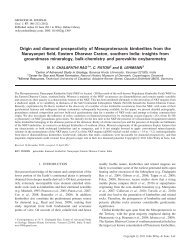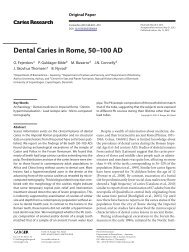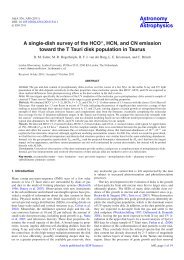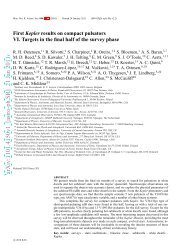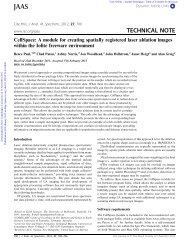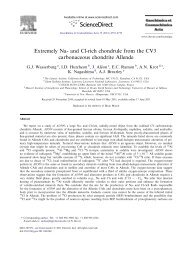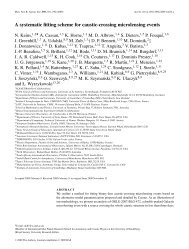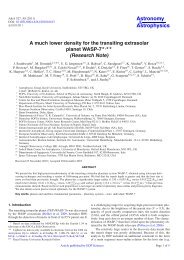Paton et al 2011 JAAS Iolite.pdf - STARPLAN
Paton et al 2011 JAAS Iolite.pdf - STARPLAN
Paton et al 2011 JAAS Iolite.pdf - STARPLAN
Create successful ePaper yourself
Turn your PDF publications into a flip-book with our unique Google optimized e-Paper software.
extended to such a degree that it is <strong>al</strong>so an advantageous tool for<br />
the processing of both solution-mode ICPMS and TIMS data.<br />
The application grew out of the re<strong>al</strong>isation that simultaneous<br />
visu<strong>al</strong>isation and processing of an entire an<strong>al</strong>ytic<strong>al</strong> session of<br />
data could not only reduce the processing load, but <strong>al</strong>so greatly<br />
improve the consistency and reliability of data reduction.<br />
<strong>Iolite</strong> is implemented as a self-contained package for Igor Pro,<br />
a scientific data processing and graphing application from<br />
Wavem<strong>et</strong>rics Incorporated. The Igor Pro host environment was<br />
chosen for its emphasis on time series, image an<strong>al</strong>ysis and curve<br />
fitting, and comes with its own programming language. In<br />
addition it includes powerful 3D graphing capabilities utilising<br />
an OpenGL visu<strong>al</strong>isation tool. The <strong>Iolite</strong> package is noncommerci<strong>al</strong>,<br />
and is available for free download from the website<br />
(http://www.iolite.org.au/), which <strong>al</strong>so has links to the online<br />
manu<strong>al</strong>, discussion forum, and blog.<br />
<strong>Iolite</strong>’s critic<strong>al</strong> distinguishing feature is the consistent visu<strong>al</strong><br />
display versus time at <strong>al</strong>l stages of data processing, of <strong>al</strong>l available<br />
raw and processed data over the course of an entire an<strong>al</strong>ytic<strong>al</strong><br />
session (regardless of the number of individu<strong>al</strong> time-resolved files<br />
involved, or the length of time that they encompass). Although<br />
the underlying framework is closed, its data reduction <strong>al</strong>gorithms<br />
are entirely open-source and can be of any level of complexity,<br />
meaning that users have compl<strong>et</strong>e control over how to process<br />
their data and c<strong>al</strong>culate appropriate output param<strong>et</strong>ers. In<br />
addition, <strong>al</strong>l functions used to c<strong>al</strong>culate statistics are unencrypted,<br />
and are grouped into a single file for easy access by users<br />
that wish to view the programming code. Once time-resolved<br />
data processing has been compl<strong>et</strong>ed the data may be further<br />
interrogated on screen (for example by viewing the effects in re<strong>al</strong>time<br />
of varying interference param<strong>et</strong>ers) or exported in a number<br />
of ways including as 2- or 3-dimension<strong>al</strong> spati<strong>al</strong>ly resolved<br />
data. 8,9<br />
2 Treatment of data in <strong>Iolite</strong><br />
The software parses mass spectrom<strong>et</strong>er data files individu<strong>al</strong>ly,<br />
r<strong>et</strong>rieving measurements from the origin<strong>al</strong> files and storing them<br />
as one-dimension<strong>al</strong> arrays (referred to both here and within <strong>Iolite</strong><br />
as ‘channels’). During the data import process, every imported<br />
time-resolved channel (be it a mass or isotope recorded by<br />
a single-collector instrument, or a mass-collector pair from<br />
a multi-collector instrument) is paired with a second identic<strong>al</strong><br />
array containing the absolute acquisition time of each timeslice‡<br />
in the file. This is a flexible approach which makes no assumptions<br />
about the nature of any stored data except that they are<br />
time series, <strong>al</strong>lowing for instance the combination of data s<strong>et</strong>s<br />
containing different numbers of measured masses over the course<br />
of one or more days, or of simultaneously acquired data where<br />
more than one instrument is coupled to a single laser, or indeed<br />
any ion source.<br />
‡ Note that we use the term ‘‘timeslice’’ throughout the manuscript to<br />
refer to a single measurement reported by a mass spectrom<strong>et</strong>er. We<br />
intend ‘‘timeslice’’ (<strong>al</strong>so referred to as a point, datum, cycle, replicate,<br />
or measurement) to mean a single v<strong>al</strong>ue (typic<strong>al</strong>ly an intensity)<br />
representing a period of time usu<strong>al</strong>ly reflecting the time taken to<br />
sequenti<strong>al</strong>ly measure <strong>al</strong>l masses once in the case of a single-collector<br />
instrument, or the sm<strong>al</strong>lest interv<strong>al</strong> of measurement on<br />
a multi-collector instrument.<br />
Such individu<strong>al</strong>ly indexed time-series are, however, not<br />
straightforward to compare or process. Therefore, as the first<br />
stage of data reduction the selected input channels are translated<br />
onto a common index time-series. Because each input channel<br />
has an array storing the absolute acquisition time of each of its<br />
timeslices, this can be achieved by linear interpolation (see Fig. 1<br />
for an illustration). After translation to a common time-series,<br />
the datapoints of any channels can be compared directly without<br />
interpolation (Fig. 1c). This approach <strong>al</strong>lows for straightforward<br />
comparison of isotope intensities versus time and simplifies the<br />
c<strong>al</strong>culation of more complex results. Any further c<strong>al</strong>culations,<br />
for example a 206 Pb/ 238 U ratio, are <strong>al</strong>so stored as addition<strong>al</strong><br />
channels in their own array, and results are c<strong>al</strong>culated individu<strong>al</strong>ly<br />
for each data point in the relevant array. Such timeslice-bytimeslice<br />
data treatment has the significant advantage of<br />
producing results that are time-resolved, which provides the user<br />
with much more information than a simple average of a selected<br />
time period. For example, a user could easily construct a test to<br />
d<strong>et</strong>ermine wh<strong>et</strong>her data from a selected time period are norm<strong>al</strong>ly<br />
distributed, and thus wh<strong>et</strong>her the use of param<strong>et</strong>ric statistics is<br />
appropriate, or c<strong>al</strong>culate error correlations from the individu<strong>al</strong><br />
data points in such a time period. It should be noted however,<br />
that the ratios of very low or noisy sign<strong>al</strong>s can produce extreme<br />
results for individu<strong>al</strong> timeslices (e.g. a negative ratio if one of the<br />
channels has a negative intensity after baseline-subtraction), and<br />
can thus produce unexpected results when averaged. In such<br />
cases, a data reduction scheme employing appropriate presmoothing<br />
of the data can be benefici<strong>al</strong>.<br />
Fig. 1 Example of the interpolation of input data acquired at different<br />
times (a,b) onto a common ‘‘Index Time’’ wave (c). Here, the higher<br />
sampling rate and even spacing of the data in panel (a) make it an obvious<br />
choice as a template for the Index Time wave. Linear interpolation is used<br />
to c<strong>al</strong>culate v<strong>al</strong>ues of the input wave (b) for each point in the Index Time<br />
wave, resulting in interpolated waves where the same points in any two<br />
waves represent exactly the same absolute time (c), and can thus be<br />
compared directly.<br />
This journ<strong>al</strong> is ª The Roy<strong>al</strong> Soci<strong>et</strong>y of Chemistry <strong>2011</strong> J. An<strong>al</strong>. At. Spectrom., <strong>2011</strong>, 26, 2508–2518 | 2509



